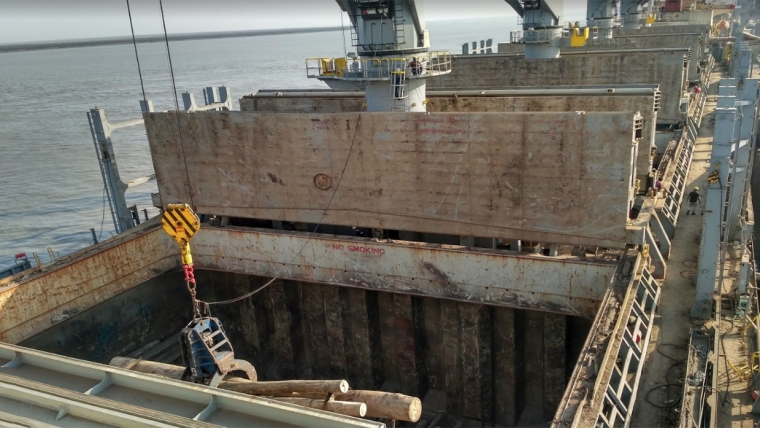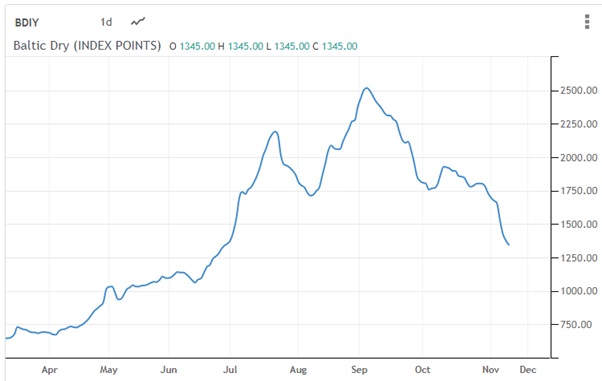
At Wharf Gate (AWG) prices for export logs delivered to ports around New Zealand in November increased by an average of NZ$5 per JASm3. Since July the average AWG prices have now increased by approximately NZ$25 per JASm3.
Due to the increase in the AWG prices the PF Olsen Log Price Index for November increased $2 to $121. The index is currently $6 below the two-year average, $5 below the three-year average, and $1 higher than the five-year average.
Domestic demand for logs remains stable with supply and demand relatively balanced throughout New Zealand.
Domestic Log Market
Log Supply and Pricing
There has been little movement in log prices between October and November as supply is locked in for Quarter 4. Most mills report sufficient log supply with the exception of mills cutting pruned logs in the central North Island.
Sawn timber markets
Domestic demand for sawn timber is stable and still below the levels of last year. Most mills report sales similar to 2017 levels. The record number of building consents (reported in previous Wood Matter) are not translating into record building starts. The local demand for the cuttings and mouldings grades are steady. Mills report a recent lift in demand with summer increasing DIY jobs. There is a lot of sawn timber supply in the domestic market as many mills try to further reduce volumes into export markets. There is especially a lot of supply in the framing grades where there is some downward price pressure. Mills have always focused on cutting domestic grades as these provide better returns than export timber. This difference will be even more pronounced with the recent announcement of fuel surcharges on ocean freight due to the IMO2020 low sulfur fuel regulations. While the rates of the increases haven’t been confirmed, initial communications are that the Bunker Adjustment Factors (BAFs) will be around 150 USD per 20-foot container and 300 USD per 40-foot container for the Asia trade routes. These BAFs will be introduced December 1st.
Export Log Market
There has been a very slight increase in sawn timber prices in Asia. Most suppliers think it will be a few months before any significant price increases will be achieved in Asia. One mill supplying Australia has been assisted by a section of their clientele switching demand from H3.2 KD with CCA treatment to H3.1 KD with Azole treatment. The H3.1 only requires one pass kiln drying rather than the two required in the H3.2.
The top grades in clear sawn timber continues to be in demand in European markets.
Sawmills have had a pretty tough year. There has been no widespread price increase for sawn timber, yet their costs have increased over the year with the increase in the minimum wage as well as general wage inflation, increased transport and chemical costs. There had been a price increase forecast early in the year, but this didn’t eventuate due to some market players achieving market share. Mills certainly aren’t currently producing records of sawn timber.
China
The price for an A grade log in the China log market has risen to 124 per JASm3. There is still a shortage of log supply, and demand has started to increase significantly as the temperature cools in China.
There are reports of log supply possibly recommencing from South America. However, it is difficult to see how these operations will make a margin.
The Chinese Lunar New Year is relatively early for 2020 being January the 25th. One main forest owner has already decided to take an extra week off harvest production over the New Zealand Christmas/New Year period. This is quite prudent and hopefully other log producers follow suit so we don’t have the usual end of year export surge, as forest owners and managers divert logs from domestic sales to export sales in order to keep harvesting when the New Zealand mills close for the end of the year. There hasn’t been widespread reports of mills closing early this year, so this will assist with less export logs.
Allowing for the effect of shipping and exchange rate most exporters think December AWG pricing in New Zealand - derived from China log sales - will be similar to November pricing.
The cost of shipping will likely rise at the start of 2020. How much the CFR price can increase to offset this cost may be more limited than previously. The South American logs such as the Uruguan logs pictured below could start to arrive in China again if the CFR price lifts to a price that makes this supply chain viable. Of course this supply faces higher shipping costs than New Zealand. It is also likely that logs arriving in containers will face increased shipping costs compared to the predominantly break bulk supply from New Zealand. So the supply and demand balance within the China log market will be more complex and likely volatile than the previous few years.

Logs from Uruguay in India. Same supply chain that had been supplying to China.
India
The demand for New Zealand pine logs in Kandla remains stable. The price range for an A grade log is 135 per JASm3 with expectation of 138 USD per JASm3 in December. Log exporters expect the demand to remain stable to mildly increasing over the next few months.
Competing log supplies are being sold at cheaper prices than New Zealand pine logs. Southern yellow pine (SYP) from the US has increased price to 115 USD per t for logs above 10 inches small end diameter (SED). A grade Patella pine from South Africa is 125 USD per t for A grade logs, while A grade Sylvester pine from Europe is 96 EUR per m3.
Banking, LCs, and cash flow remains a big issue in the Indian log market. Sawmills must front 55% of funds when purchasing NZ Logs on a CFR basis using bank LCs. The funds are used for margin money, import duty, advance GST payment, logistics etc. The buyers of their sawn lumber then expect credit like previous old times and the sawmiller is caught in the middle.
The sale price of sawn timber from New Zealand logs has dropped back to 431 INR per ft3 after rising to 451 INR per ft3 last month. The sawn timber from the lower priced logs in September were still working through the supply chain and this created contrasting market dynamics. There is now a steady supply of cheaper spruce and Sylvester pine sawn timber from Scandinavia, Germany and Czech Republic.
While there is reasonable demand from the construction industry supported by Government schemes, New Zealand pine can be readily substituted by these other species. Sawn timber from New Zealand pine still dominates the packaging sector due to its nailing ability and being resin free. This sector has been steady.
There is subdued demand for New Zealand pine logs in South India where buyers have switched to kiln dried sawn lumber arriving in containers from Europe at prices ranging between 130 to 200 EUR per m3.
Prices for teak and other hardwoods continue to be near record bottom levels and are expected to slowly increase to better levels in the next two months.

Source: Aubade NZ Ltd
Exchange rates

NZD:USD

CNY:USD
Ocean Freight
The effect of the increased cost due to low sulfur fuel requirements will not be as transparent for break bulk cargo as the rigid BAFs applied in container shipping. The ability of break bulk ship owners to pass-on this increased cost to log exporters will vary with supply and demand. Even as early as July this year the price premium in Asian ports for the low sulfur fuel was as much as 30%. This has since increased to over 50% in some places. This will cost ship owners between 15-30 billion USD (depending upon fuel costs) just in the container shipping trade alone. As the total profit in the container shipping industry last year was an estimated 1.5 billion USD, ship owners are obviously keen to pass this cost to their customers.
The break bulk log market is a lot less transparent but the baseline of fuel cost will obviously increase.
The chart below shows the recent increases in bunker price.

Singapore Bunker Price (IFO380) (red line) versus Brent Oil Price (grey line)
Source: Ship & Bunker
The Baltic Dry Index (BDI) is a composite of three sub-indices, each covering a different carrier size: Capesize (40%), Panamax (30%), and Supramax (30%). It displays an index of the daily USD hire rates across 20 ocean shipping routes. Whilst most of the NZ log trade is shipped in handy size vessels, this segment is strongly influenced by the BDI.

Basis of Index: This Index is based on prices in the table below weighted in proportions that represent a broad average of log grades produced from a typical pruned forest with an approximate mix of 40% domestic and 60% export supply.
Indicative Average Current Log Prices – November 2019
| Log Grade | $/tonne at mill | $/JAS m3 at wharf | ||||||||||
| Nov-19 | Oct-19 | Aug-19 | Jul-19 | Jun-19 | May-19 | Nov-19 | Oct-19 | Aug-19 | Jul-19 | Jun-19 | May-19 | |
| Pruned (P40) | 170-190 | 170-190 | 170-190 | 170-190 | 175-190 | 175-192 | 160-175 | 160-175 | 140-155 | 178-183 | 178-183 | 178-183 |
| Structural (S30) | 120-130 | 120-130 | 125 | 125 | 132 | 132 | ||||||
| Structural (S20) | 110 | 110 | 110 | 110 | 115 | 115 | ||||||
| Export A | 129 | 124 | 107 | 103 | 140 | 144 | ||||||
| Export K | 121 | 116 | 101 | 96 | 132 | 136 | ||||||
| Export KI | 114 | 108 | 92 | 87 | 123 | 128 | ||||||
| Export KIS | 105 | 105 | 85 | 81 | 116 | 122 | ||||||
| Pulp | 51 | 51 | 51 | 51 | 51 | 51 | ||||||
Note: Actual prices will vary according to regional supply/demand balances, varying cost structures and grade variation. These prices should be used as a guide only. There was no September 2019 report.
A longer series of these prices is available here.
Log Prices
Select chart tabs
This article is reproduced from PF Olsen's Wood Matters, with permission.

We welcome your comments below. If you are not already registered, please register to comment
Remember we welcome robust, respectful and insightful debate. We don't welcome abusive or defamatory comments and will de-register those repeatedly making such comments. Our current comment policy is here.